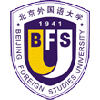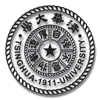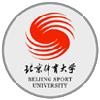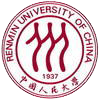Beijing Dining
Beijing is a food connoisseur's paradise, offering an array of Chinese and Western cuisines guaranteed to please the palate. The city's major restaurants are in the hands of famous chefs with creative techniques, and the dining environment is elegant and cozy. Ordinary restaurants in the streets are cheap, practical; and offer a unique Chinese ambiance. Generally speaking, meals in the major hotels and fine dining restaurants are more expensive than meals in local restaurants. Credit cards and checks are accepted in most hotels and restaurants, but there will be an additional 10-15% service charge. Below is an introduction to some of the different cuisines available in Beijing.
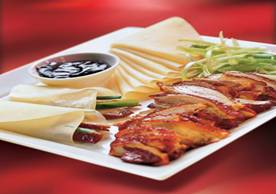 Beijing
is famous for its Peking Duck, and so a Peking Duck dinner should be a fixed
itinerary on any Beijing tour. With hundreds of restaurants offering this
specialty, Quanjude Peking Duck Restaurant is the recognized leader for
serving the best Peking Duck around town. With over 130 years of history,
there are now branch restaurants in Qianmen, Hepingmen and Wangfujing. But
one of the best places we've found for Peking Duck is Da Dong Kao Ya. Beijing
is famous for its Peking Duck, and so a Peking Duck dinner should be a fixed
itinerary on any Beijing tour. With hundreds of restaurants offering this
specialty, Quanjude Peking Duck Restaurant is the recognized leader for
serving the best Peking Duck around town. With over 130 years of history,
there are now branch restaurants in Qianmen, Hepingmen and Wangfujing. But
one of the best places we've found for Peking Duck is Da Dong Kao Ya.
Peking ducks are marinated with a secret sauce recipe and then roasted directly over fruittree wood stoked flames. When roasted to perfection, the ducks are date-red in color, lightly glazed with oil and have crispy skin and are tender with meat. The chef then shaves the meat into thin slices with skin attached. The meat is served with Chinese onions, special sweet sauce and wrapped by a very thin pancake.
Quan Ju De Roast Duck Restaurant (Qianmen Branch)
Address: 32, Qianmen Street, Chongwen District
Opening hours: 11:00 am - 1:30 pm, 4:30 pm - 8:30 pm
Transportation: Bus No 20, 17, 53, 22, 59, 819, 110
Quanjude Roast Duck Restaurant (Wangfujing Branch)
Address: 9, Shuaifuyuan Hutong, Wangfujing Street, Dongcheng District
Opening hours: 11:00 am - 1:30 pm, 4:30 pm - 8:00 pm
Transportation: Bus No. 803
Da Dong Roast Duck Restaurant (Tuanjie Lake Branch)
Address: 3, Tuanjie Lake, Chaoyang District
Opening hours: 10:00 am - 10:00 pm
Transportation: Bus No.105, 108
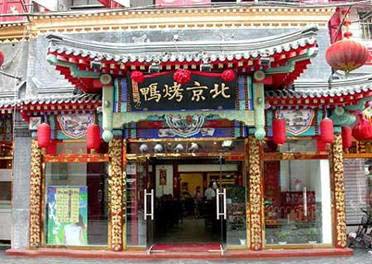
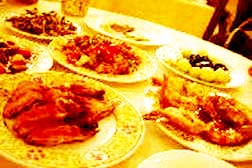 Beijing has been the Capital of the Liao (907-1125), Jin (1115-1234), Yuan (1206-1368), Ming (1368-1644) and Qing (1644-1911) Dynasties. Because of its rich cultural history, Imperial Food, or a special a style of Chinese food originating from the Imperial Palace was formed. In bygone days these dishes were exquisitely made with choice ingredients and were prepared in the imperial palace kitchen for the exclusive delight of the emperor. Today, Fangshan Restaurant in Beihai Park, Tingliguan Restaurant in the Summer Palace, and Dashanyuan Restaurant near Palace Museum, have made these once secret dishes available to the public. Beijing has been the Capital of the Liao (907-1125), Jin (1115-1234), Yuan (1206-1368), Ming (1368-1644) and Qing (1644-1911) Dynasties. Because of its rich cultural history, Imperial Food, or a special a style of Chinese food originating from the Imperial Palace was formed. In bygone days these dishes were exquisitely made with choice ingredients and were prepared in the imperial palace kitchen for the exclusive delight of the emperor. Today, Fangshan Restaurant in Beihai Park, Tingliguan Restaurant in the Summer Palace, and Dashanyuan Restaurant near Palace Museum, have made these once secret dishes available to the public.
Fangshan Restaurant
Address: 1, Wenjin Jie, inside Beihai Park
Opening hours: 11:00 am - 1:30 pm; 5:00 pm- 7:30 pm
Tan Family Restaurant Beijing Hotel (Tan Jia Cai)
Address: 7/F, Unit C, Beijing Hotel, 33, Dong Changan Jie, Dongcheng District
Opening hours: 11:30 am - 2:00 pm 5:30 pm - 9:30 pm
Guoyao Xiaoju
Address: 58, Jiaodaokou Bei Santiao, Dongcheng District
Opening hours: 9:00 am - 10:00 pm
Haitang Ju
Address: 32, Xi Houheyan Jie, Xuanwumen, Xuanwu District
Opening hours: 10:00 am - 10:00 pm
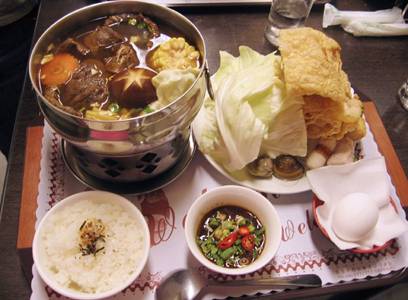 Hotpot
is very popular among Beijingers, especially during winter season. The concept
is for you to cook your food at your table in a big pot full of soup that
sits over a burner. Customers choose from a wide selection of thinly sliced
fresh raw meats and vegetables (including tofu, Chinese cabbage and bean
sprouts). Noodles and seasonings are served, and the Hotpot experience begins.
Items are picked up and immersed in boiling soup until it is cooked. When
removed, meats and vegetables are ready to eat and can be dipped in peanut,
soy, sesame, and chili sauces. Hotpot
is very popular among Beijingers, especially during winter season. The concept
is for you to cook your food at your table in a big pot full of soup that
sits over a burner. Customers choose from a wide selection of thinly sliced
fresh raw meats and vegetables (including tofu, Chinese cabbage and bean
sprouts). Noodles and seasonings are served, and the Hotpot experience begins.
Items are picked up and immersed in boiling soup until it is cooked. When
removed, meats and vegetables are ready to eat and can be dipped in peanut,
soy, sesame, and chili sauces.
There are basically two kinds of Hotpot restaurants in Beijing: Mongolian and Sichuan style. Sichuan hotpot has a soup base, which can be described as either super spicy or mildly radioactive. But for those sensitive to spicy food, there is no need to worry because often the pot is divided in half: one side spicy soup, the other half for non-spicy soup. The soup base for Mongolian style is not spicy, and usually consists of some vegetables and seafood.
Recently there has been an explosion of buffet-style hotpot restaurants. Generally you pay a set price (often around RMB 38) for an "all you can eat" meal, including beer.
Neng Ren Ju Restaurant
Address: 135, Xi Da Jie, Qianmen
Opening hours: 11:00am - 11:00 pm
Hai Di Lao (Da Hui Temple Branch)
Address: 2, Da Hui Temple Lu, Haidian District
Opening hours: 10:00 am - 10:00 pm
Dong Lai Shun Restaurant (Jianguomen Branch)
Address: 2, Xiaoyangmao Hutong, Jianguomennei Da Jie, Dongcheng Distrct
Opening hours: 9:30 am - 9:30 pm
Chongqing Jinshancheng Hotpot (Huayuanqiao Branch)
Address: 12, Bei Wa Lu (inside Zhongzi Mansion), Haidian District
Opening hours:11:00 am - 11:00 pm
Tiandu Chongqing Hotpot Restaurant
Address: 86, Xueyuan Nan Lu, Haidian District
Opening hours: 11:30 am - 11:00 pm
Xiaofeiyang (Tiantongyuan Branch)
Address: 21, Tiantongyuan, Changping District
Opening hours: 11:00 am - 10:00 pm
Huang Cheng Lao Ma (Dewai Branch)
Address: 9, Jiaochangkou Jie, Xicheng District
Opening hours:11:00 am - 12:00 pm
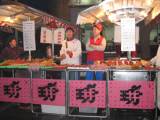 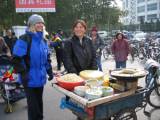 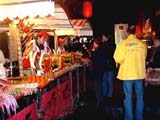
There are a good variety of traditional local snacks and refreshments in Beijing. These include almond junket, milk curd, tiny corn buns, porridge with lotus seeds, cakes stuffed with minced meat are baked in a clay oven,, fermented soy bean milk, sausages, odd-odor bean curd, sesame seed-speckled cakes, sweet sour plum juice and more.
The best snacks are found at night fairs, where traditional lanterns add a folkloric aura to scene. Beijing's open-air night snack markets are open all year round. For a taste of snack foods, go to Snack Street, near Wangfujing Street or Donghuamen near the Palace Hotel. From about 5:00 pm, vendors lined up in their stalls start selling foods from all parts of the country. You can have an entire meal's worth of food walking from one end of the street to the other, sampling various delicacies along the way. These markets provide real life accounts of how the Chinese enjoy their evenings.
Tan Gen Yuan Restaurant (a cultural restaurant)
Address: A1, Dongmenwai, Ditan Park
Opening hours: 10: 30 am - 2:00pm 5:00 pm- 10:30 pm
Sha Guo Ju
Address: 60 Xisi Nan Da Jie, Xicheng District
Opening hours: 11:30 am - 1:30 pm 5:00 pm - 10:00 pm
Da Wan Cha Restaurant
Address: 3F Bldg. 3 Zhengyang Market, Qianmen Xi Jie, Chongwen District
Opening hours: 9:00 am - 10:00 pm
You Yi Shun Restaurant
Address: 28 Huangsi Jie, Desheng Men, Xicheng District
Opening hours: 10:30 am - 10:00 pm
Wangfujing Night Street Food Market
Address: Donghua Men, Wangfujing, Dongcheng District, Beijing
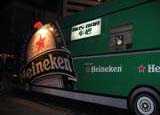 Apart
from the thousands of restaurants serving Chinese dishes, Beijing's gourmet
scene is also filled with restaurants serving Italian, French, American,
Russian, Japanese, Thai, Indonesian, Korean and other foreign cuisine. Fast
food outlets such as McDonald's, Kentucky Fried Chicken, Pizza Hut and the
likes are spotted throughout the city. Apart
from the thousands of restaurants serving Chinese dishes, Beijing's gourmet
scene is also filled with restaurants serving Italian, French, American,
Russian, Japanese, Thai, Indonesian, Korean and other foreign cuisine. Fast
food outlets such as McDonald's, Kentucky Fried Chicken, Pizza Hut and the
likes are spotted throughout the city.
Chaoyang Street and Sanlitun Bar Street offer the most bars and cafes. These places are decorated with a western atmosphere, enabling foreigners to feel more at home. These are good places for those wishing to relax by sipping a cup of coffee or sampling some vintage brews.
Drinking alcohol is a big part of Beijing entertainment, especially when dining with Chinese hosts. The Chinese likes to drink beer and BaiJiu (Chinese white wine) made from assorted grains. There are varying degrees of Bai Jiu. The Beijing favorite is called Er Guo Tou, which contains 56% alcohol, and costs about RMB 5 per bottle. Wuliangye and Maotai, going for about RMB 300-400 RMB per bottle is less alcohol intensive. Non-drinkers or those who don't feel up to the challenge can politely decline by saying they don't drink. It is generally acceptable to use soda or tea as an alcohol substitute.
| Some Eating Areas Around Beijing |
Chaoyang Park
This humble park is undergoing a transformation to become one of the hippest spots for dining and drinking. With all kinds of specialty cuisines, Prices generally range from medium to high.
Haidian
The university area is home to many cheap local restaurants serving excellent Chinese food. Wudaokou (also known as Korea Town) in Haidian, has many authentic Korean restaurants catering to the large Korean student population.
Jianguomenwai/Ritan
From fast food to fine dining, Chinese or foreign, this area has it all. For Chinese food offering romantic settings and affordable prices, Xi He Ya Ju near Ritan Park is a good choice. Adria is an excellent choice for those craving wood fired pizza.
Northeast Third Ring Road
This section is known for its many restaurants. For those wanting authentic Thai food in an elegant setting, try the Red Basil. For those on a budget, try the Asian Star. For Japanese food at reasonable prices, try Sansi Lang. For American food, there's the Hard Rock Cafe and T.G.I. Fridays. For Cuban food in a festive atmosphere, the Salsa Cabana is the place to be.
Sanlitun
For drinks and Japanese munchies, try Jazz Ya. For Indian/Thai food, there's the Golden Elephant. For burgers, fries and other pub food, there's the Downtown Caf¨¦ and Franks Place. For ambience with Cuban rhythms and tunes, go to Havana.
| General Chinese Dining Practice |
| |
Western |
Chinese |
| Utensils |
Fork & knife |
Chopsticks |
| Food |
Individual plate of food |
Many shared dishes |
| Amount of Food Ordered |
Just enough |
Over-order food |
| Drink |
Wine |
Beer or Bai Jiu (Chinese White wine) |
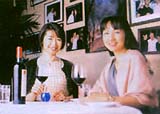
- Utensils
When eating Chinese food, most people use chopsticks; however, you can ask for a fork and knife if you find those more useful
- Food: Share or Not
When eating western food, people order their own plate of food; but in China the dishes are placed on the table and everyone shares.
- Amount of Food Ordered
If invited to a formal dinner, and as a sign of hospitality and generosity, the Chinese host generally tends to over-order food. That is because the Chinese finds it embarrassing should the guest feel inadequately fed or thinks there wasn't enough variety in dishes. Once you have eaten enough, politely tell them you are full and the pressure to eat more will be lessened.
- Another Sign of Hospitality
Again as a sign of hospitality, Chinese hosts may put food from the various dished onto the guest's plate. Usually food is served using communal serving utensils, but some hosts may use their own chopsticks, a sign of genuine friendship. It is always polite to eat a portion of or all the food. What you can't finish it, just leave on the plate.
Back to top
| Taboos Surrounding Chinese Table Manners |
Traditionally speaking, there are some taboos surrounding Chinese Table Manners. Some things to keep in mind include:
- About Chopsticks
Lay your chopsticks on your dish; do not stick your them upright in the rice bowl, for that gesture symbolizes death to the Chinese people. Do not tap your chopsticks against your bowl, because the Chinese would see that as a beggar's motion.
- About Teapots
Make sure the spout of the teapot is not facing anyone because that would be equivalent to the impolite gesture of pointing. The teapot spout should always be directed to where nobody is sitting.
Not all the tap water in China is potable, but bottled mineral water is on sale everywhere.
NOTE:
Although this information is correct at the time of our web publication,
it is still advised that you call the phone number and confirm
the address before going to the venue because some venues may
have changed their telephone numbers or address locations. |

 Beijing
is famous for its Peking Duck, and so a Peking Duck dinner should be a fixed
itinerary on any Beijing tour. With hundreds of restaurants offering this
specialty, Quanjude Peking Duck Restaurant is the recognized leader for
serving the best Peking Duck around town. With over 130 years of history,
there are now branch restaurants in Qianmen, Hepingmen and Wangfujing. But
one of the best places we've found for Peking Duck is Da Dong Kao Ya.
Beijing
is famous for its Peking Duck, and so a Peking Duck dinner should be a fixed
itinerary on any Beijing tour. With hundreds of restaurants offering this
specialty, Quanjude Peking Duck Restaurant is the recognized leader for
serving the best Peking Duck around town. With over 130 years of history,
there are now branch restaurants in Qianmen, Hepingmen and Wangfujing. But
one of the best places we've found for Peking Duck is Da Dong Kao Ya. 
 Beijing has been the Capital of the Liao (907-1125), Jin (1115-1234), Yuan (1206-1368), Ming (1368-1644) and Qing (1644-1911) Dynasties. Because of its rich cultural history, Imperial Food, or a special a style of Chinese food originating from the Imperial Palace was formed. In bygone days these dishes were exquisitely made with choice ingredients and were prepared in the imperial palace kitchen for the exclusive delight of the emperor. Today, Fangshan Restaurant in Beihai Park, Tingliguan Restaurant in the Summer Palace, and Dashanyuan Restaurant near Palace Museum, have made these once secret dishes available to the public.
Beijing has been the Capital of the Liao (907-1125), Jin (1115-1234), Yuan (1206-1368), Ming (1368-1644) and Qing (1644-1911) Dynasties. Because of its rich cultural history, Imperial Food, or a special a style of Chinese food originating from the Imperial Palace was formed. In bygone days these dishes were exquisitely made with choice ingredients and were prepared in the imperial palace kitchen for the exclusive delight of the emperor. Today, Fangshan Restaurant in Beihai Park, Tingliguan Restaurant in the Summer Palace, and Dashanyuan Restaurant near Palace Museum, have made these once secret dishes available to the public.  Hotpot
is very popular among Beijingers, especially during winter season. The concept
is for you to cook your food at your table in a big pot full of soup that
sits over a burner. Customers choose from a wide selection of thinly sliced
fresh raw meats and vegetables (including tofu, Chinese cabbage and bean
sprouts). Noodles and seasonings are served, and the Hotpot experience begins.
Items are picked up and immersed in boiling soup until it is cooked. When
removed, meats and vegetables are ready to eat and can be dipped in peanut,
soy, sesame, and chili sauces.
Hotpot
is very popular among Beijingers, especially during winter season. The concept
is for you to cook your food at your table in a big pot full of soup that
sits over a burner. Customers choose from a wide selection of thinly sliced
fresh raw meats and vegetables (including tofu, Chinese cabbage and bean
sprouts). Noodles and seasonings are served, and the Hotpot experience begins.
Items are picked up and immersed in boiling soup until it is cooked. When
removed, meats and vegetables are ready to eat and can be dipped in peanut,
soy, sesame, and chili sauces.


 Apart
from the thousands of restaurants serving Chinese dishes, Beijing's gourmet
scene is also filled with restaurants serving Italian, French, American,
Russian, Japanese, Thai, Indonesian, Korean and other foreign cuisine. Fast
food outlets such as McDonald's, Kentucky Fried Chicken, Pizza Hut and the
likes are spotted throughout the city.
Apart
from the thousands of restaurants serving Chinese dishes, Beijing's gourmet
scene is also filled with restaurants serving Italian, French, American,
Russian, Japanese, Thai, Indonesian, Korean and other foreign cuisine. Fast
food outlets such as McDonald's, Kentucky Fried Chicken, Pizza Hut and the
likes are spotted throughout the city. 
